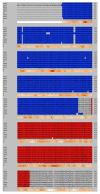The Thiamine diphosphate dependent Enzyme Engineering Database: a tool for the systematic analysis of sequence and structure relations
- PMID: 20122171
- PMCID: PMC2831816
- DOI: 10.1186/1471-2091-11-9
The Thiamine diphosphate dependent Enzyme Engineering Database: a tool for the systematic analysis of sequence and structure relations
Abstract
Background: Thiamine diphosphate (ThDP)-dependent enzymes form a vast and diverse class of proteins, catalyzing a wide variety of enzymatic reactions including the formation or cleavage of carbon-sulfur, carbon-oxygen, carbon-nitrogen, and especially carbon-carbon bonds. Although very diverse in sequence and domain organisation, they share two common protein domains, the pyrophosphate (PP) and the pyrimidine (PYR) domain. For the comprehensive and systematic comparison of protein sequences and structures the Thiamine diphosphate (ThDP)-dependent Enzyme Engineering Database (TEED) was established.
Description: The TEED http://www.teed.uni-stuttgart.de contains 12048 sequence entries which were assigned to 9443 different proteins and 379 structure entries. Proteins were assigned to 8 different superfamilies and 63 homologous protein families. For each family, the TEED offers multisequence alignments, phylogenetic trees, and family-specific HMM profiles. The conserved pyrophosphate (PP) and pyrimidine (PYR) domains have been annotated, which allows the analysis of sequence similarities for a broad variety of proteins. Human ThDP-dependent enzymes are known to be involved in many diseases. 20 different proteins and over 40 single nucleotide polymorphisms (SNPs) of human ThDP-dependent enzymes were identified in the TEED.
Conclusions: The online accessible version of the TEED has been designed to serve as a navigation and analysis tool for the large and diverse family of ThDP-dependent enzymes.
Figures


Similar articles
-
A standard numbering scheme for thiamine diphosphate-dependent decarboxylases.BMC Biochem. 2012 Nov 17;13:24. doi: 10.1186/1471-2091-13-24. BMC Biochem. 2012. PMID: 23157214 Free PMC article.
-
The modular structure of ThDP-dependent enzymes.Proteins. 2014 Oct;82(10):2523-37. doi: 10.1002/prot.24615. Epub 2014 Jun 9. Proteins. 2014. PMID: 24888727
-
Domain relationships in thiamine diphosphate-dependent enzymes.Acc Chem Res. 2006 Aug;39(8):550-7. doi: 10.1021/ar068022z. Acc Chem Res. 2006. PMID: 16906751
-
Frontiers in the enzymology of thiamin diphosphate-dependent enzymes.Curr Opin Struct Biol. 2022 Oct;76:102441. doi: 10.1016/j.sbi.2022.102441. Epub 2022 Aug 18. Curr Opin Struct Biol. 2022. PMID: 35988322 Review.
-
Structure, mechanism and catalytic duality of thiamine-dependent enzymes.Cell Mol Life Sci. 2007 Apr;64(7-8):892-905. doi: 10.1007/s00018-007-6423-5. Cell Mol Life Sci. 2007. PMID: 17429582 Free PMC article. Review.
Cited by
-
Diversity of ThDP-Dependent Enzymes Forming Chiral Tertiary Alcohols.Chembiochem. 2025 Jul 11;26(13):e202500200. doi: 10.1002/cbic.202500200. Epub 2025 May 27. Chembiochem. 2025. PMID: 40228089 Free PMC article. Review.
-
Derivatives of Natural Organocatalytic Cofactors and Artificial Organocatalytic Cofactors as Catalysts in Enzymes.Chembiochem. 2022 Jul 5;23(13):e202100599. doi: 10.1002/cbic.202100599. Epub 2022 Apr 1. Chembiochem. 2022. PMID: 35302276 Free PMC article. Review.
-
Insight into the functional roles of Glu175 in the hyperthermostable xylanase XYL10C-ΔN through structural analysis and site-saturation mutagenesis.Biotechnol Biofuels. 2018 Jun 8;11:159. doi: 10.1186/s13068-018-1150-8. eCollection 2018. Biotechnol Biofuels. 2018. PMID: 29930705 Free PMC article.
-
A standard numbering scheme for thiamine diphosphate-dependent decarboxylases.BMC Biochem. 2012 Nov 17;13:24. doi: 10.1186/1471-2091-13-24. BMC Biochem. 2012. PMID: 23157214 Free PMC article.
-
Bacterial Branched-Chain Amino Acid Biosynthesis: Structures, Mechanisms, and Drugability.Biochemistry. 2017 Nov 7;56(44):5849-5865. doi: 10.1021/acs.biochem.7b00849. Biochemistry. 2017. PMID: 28977745 Free PMC article. Review.
References
Publication types
MeSH terms
Substances
LinkOut - more resources
Full Text Sources
Other Literature Sources
Molecular Biology Databases
Miscellaneous

